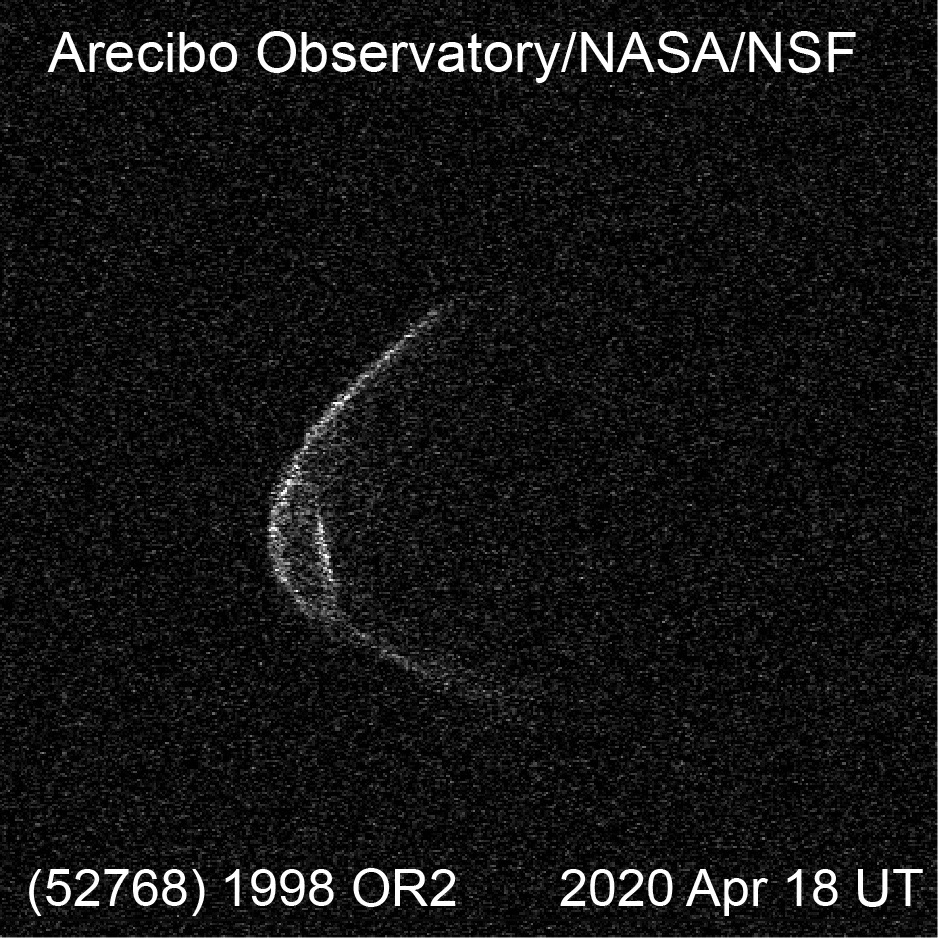Big asteroid shows itself ahead of Earth flyby on April 29 (photo)

We've now got a good visual on the big space rock that's going to fly by Earth next week.
On Saturday (April 18), the Arecibo Observatory in Puerto Rico captured a radar image of the asteroid 1998 OR2, which will zoom within 3.9 million miles (6.3 million kilometers) of our planet on April 29.
For perspective: The moon orbits Earth at an average distance of about 239,000 miles (385,000 km). So we have nothing to fear from asteroid 1998 OR2's Earth flyby on April 29, scientists stress.
Related: Potentially dangerous asteroids (images)
Arecibo team members have been wearing masks in the workplace to help minimize the spread of the novel coronavirus, and they apparently see a bit of themselves in the approaching space rock.
"#TeamRadar and the @NAICobservatory staff are taking the proper safety measures as we continue observations. This week we have been observing near-Earth asteroid 1998 OR2, which looks like it's wearing a mask! It's at least 1.5 km across and is passing 16 lunar distances away!" team members tweeted on Saturday via the @AreciboRadar account. (@AreciboRadar is not an official Arecibo account. But @NAICobservatory is, and it retweeted the April 18 post.)
#TeamRadar and the @NAICobservatory staff are taking the proper safety measures as we continue observations. This week we have been observing near-Earth asteroid 1998 OR2, which looks like it's wearing a mask! It's at least 1.5 km across and is passing 16 lunar distances away! pic.twitter.com/X2mQJCT2QgApril 18, 2020
The Arecibo researchers aren't the only ones keeping an eye on 1998 OR2. For example, Italian astrophysicist Gianluca Masi, who runs the online Virtual Telescope Project, has been tracking the asteroid as well.
Breaking space news, the latest updates on rocket launches, skywatching events and more!
And Masi will continue to do so. On April 28, in fact, he will host a live webcast about 1998 OR2 that will feature telescope views of the object.
Astronomers estimate that 1998 OR2 is between 1.1 and 2.5 miles (1.8 to 4.1 kilometers) wide — big enough that an impact could threaten human civilization. But, to repeat, there is nothing to fear here; the asteroid will miss us by a large margin on April 29.
Indeed, you should quell any general death-from-above fears that may be running rampant in your head. NASA has found and tracked the vast majority of giant near-Earth asteroids, and none of them pose a threat to Earth for the foreseeable future.
- The hunt for dangerous asteroids: here's how scientists do it
- NASA wants a new space telescope to hunt asteroids that may threaten Earth
- Planetary defense joins NASA's menu for next decadal survey focus
Mike Wall is the author of "Out There" (Grand Central Publishing, 2018; illustrated by Karl Tate), a book about the search for alien life. Follow him on Twitter @michaeldwall. Follow us on Twitter @Spacedotcom or Facebook.
OFFER: Save 45% on 'All About Space' 'How it Works' and 'All About History'!
For a limited time, you can take out a digital subscription to any of our best-selling science magazines for just $2.38 per month, or 45% off the standard price for the first three months.

Michael Wall is a Senior Space Writer with Space.com and joined the team in 2010. He primarily covers exoplanets, spaceflight and military space, but has been known to dabble in the space art beat. His book about the search for alien life, "Out There," was published on Nov. 13, 2018. Before becoming a science writer, Michael worked as a herpetologist and wildlife biologist. He has a Ph.D. in evolutionary biology from the University of Sydney, Australia, a bachelor's degree from the University of Arizona, and a graduate certificate in science writing from the University of California, Santa Cruz. To find out what his latest project is, you can follow Michael on Twitter.

